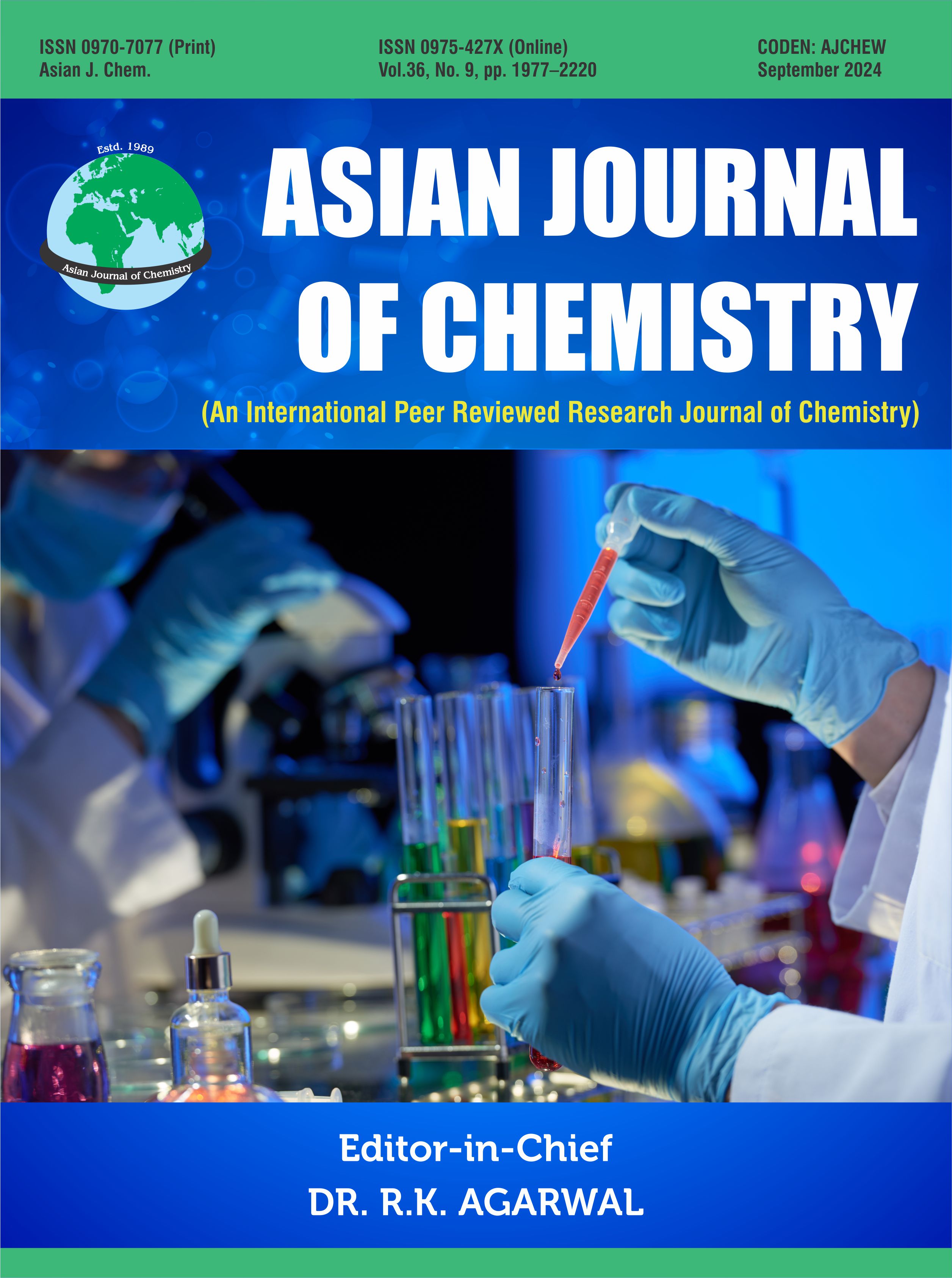Copyright (c) 2024 Shivani Sehgal, Biswa Prakash Nayak, Ikramul Haque, Rishabh Tiwari

This work is licensed under a Creative Commons Attribution 4.0 International License.
Comparison of Fabrication Process of Poly(methyl methacrylate) (PMMA) Membranes and their Amine Functionalization Studies for Application in Biosensing
Corresponding Author(s) : B.P. Nayak
Asian Journal of Chemistry,
Vol. 36 No. 9 (2024): Vol 36 Issue 9, 2024
Abstract
The comparison of the fabrication process of poly(methyl methacrylate) (PMMA) membranes and their functionalization on the basis of various characterization studies to produce a robust, stable and adherent amine functionalized surface for application in biosensing was attempted in present work. PMMA membrane fabricated using solution casting and compression moulding were characterized morphologically using electron microscopy (SEM) and functionalized with O2, N2 and He plasma at the same discharge conditions followed by deposition of (3-aminopropyl)triethoxysilane (3-APTES), an alkoxysilane, on the membranes in three different concentrations (5%, 10% and 15%). Using contact angle measurements, changes within the surface hydrophilicity were determined for pristine PMMA, plasma treated and plasma followed by 3-APTES treated PMMA membranes while amine functionalization was confirmed by Fourier transform infrared spectroscopy (FTIR). Further, the density of reactive amine groups on the membrane was estimated using fluorescent reagent in confocal microscope, which revealed that although all the plasma and 3-APTES treatments resulted in functionalization of PMMA membranes, however treatment with He plasma and 10% APTES displayed 10 to 15 times more reactive amine groups on PMMA membranes in comparison to the other plasma and 3-APTES treatments. Moreover, among the two fabricated membranes, it was found that solution casted PMMA membrane yielded twice more reactive amine groups than the compression moulded membrane. The results suggested the stability and ability of He plasma and 10% APTES treated PMMA membrane to immobilize DNA and other biomolecules efficiently and thereby can act as biosensing platform.
Keywords
Download Citation
Endnote/Zotero/Mendeley (RIS)BibTeX
- D. Laws and M. Riordan, IEEE Ann. Hist. Comput., 34, 20 (2012); https://doi.org/10.1109/MAHC.2011.87
- S.C. Terry, J.H. Jerman and J.B. Angell, IEEE Trans. Electron Dev., 12, 1880 (1979); https://doi.org/10.1109/T-ED.1979.19791
- A. Manz, N. Graber and H.Á. Widmer, Sens. Actuators B Chem., 1, 244 (1990); https://doi.org/10.1016/0925-4005(90)80209-I
- M.G. Mauk, J. Song, C. Liu and H.H. Bau, Biosensors, 8, 17 (2018); https://doi.org/10.3390/bios8010017
- T.Y. Kim, S. Kim, J.H. Jung and M.A. Woo, Biochip J., 17, 263 (2023); https://doi.org/10.1007/s13206-023-00101-7
- H.M. Kim and N.Y. Lee, Chemosensors, 12, 75 (2024); https://doi.org/10.3390/chemosensors12050075
- R.J. Martín-Palma, M. Manso, J. Pérez-Rigueiro, J.P. García-Ruiz and J.M. Martínez-Duart, J. Mater. Res., 19, 2415 (2004); https://doi.org/10.1557/JMR.2004.0321
- K.M. Horsman, J.M. Bienvenue, K.R. Blasier and J.P. Landers, J. Forensic Sci., 52, 784 (2007); https://doi.org/10.1111/j.1556-4029.2007.00468.x
- M. Rowinska, S.M. Kelleher, F. Soberon, A.J. Ricco and S. Daniels, J. Mater. Chem. B Mater. Biol. Med., 3, 135 (2015); https://doi.org/10.1039/C4TB01748J
- Z.J. Jaffer, S.N. Mazhir, M.K. Khalaf and M.S. Hanon, J. Physics: Conf. Series, 1829, 012010 (2021); https://doi.org/:10.1088/1742-6596/1829/1/012010
- T. Homola, J. Matoušek, B. Hergelová, M. Kormunda, L.Y. Wu and M. Èernák, Polym. Degrad. Stab., 97, 886 (2012); https://doi.org/10.1016/j.polymdegradstab.2012.03.029
- G. Bae, T. Park and I.H. Song, Micromachines, 13, 1952 (2022); https://doi.org/10.3390/mi13111952
- M. Sypabekova, A. Hagemann, D. Rho and S. Kim, Biosensors, 13, 36 (2022); https://doi.org/10.3390/bios13010036
- E. Abdel-Fattah, Coatings, 9, 228 (2019); https://doi.org/10.3390/coatings9040228
- R. Wang, Y. Shen, C. Zhang, P. Yan and T. Shao, Appl. Surf. Sci., 367, 401 (2016); https://doi.org/10.1016/j.apsusc.2016.01.199
- M. Lee, M.J. Lopez-Martinez, A. Baraket, N. Zine, J. Esteve, J.A. Plaza, N. Jaffrezic-Renault and A. Errachid, J. Polym. Sci. A Polym. Chem., 51, 59 (2013); https://doi.org/10.1002/pola.26387
- A. Zarinwall, T. Waniek, R. Saadat, H. Sturm, G. Garnweitner and U. Braun, Langmuir, 37, 171 (2021); https://doi.org/10.1021/acs.langmuir.0c02682
- S. Sehgal, B.P. Nayak, I. Haque and R. Tiwari, J. Forensic Med. Toxicol., 40, 107 (2023); https://doi.org/10.5958/0974-4568.2023.00051.0
References
D. Laws and M. Riordan, IEEE Ann. Hist. Comput., 34, 20 (2012); https://doi.org/10.1109/MAHC.2011.87
S.C. Terry, J.H. Jerman and J.B. Angell, IEEE Trans. Electron Dev., 12, 1880 (1979); https://doi.org/10.1109/T-ED.1979.19791
A. Manz, N. Graber and H.Á. Widmer, Sens. Actuators B Chem., 1, 244 (1990); https://doi.org/10.1016/0925-4005(90)80209-I
M.G. Mauk, J. Song, C. Liu and H.H. Bau, Biosensors, 8, 17 (2018); https://doi.org/10.3390/bios8010017
T.Y. Kim, S. Kim, J.H. Jung and M.A. Woo, Biochip J., 17, 263 (2023); https://doi.org/10.1007/s13206-023-00101-7
H.M. Kim and N.Y. Lee, Chemosensors, 12, 75 (2024); https://doi.org/10.3390/chemosensors12050075
R.J. Martín-Palma, M. Manso, J. Pérez-Rigueiro, J.P. García-Ruiz and J.M. Martínez-Duart, J. Mater. Res., 19, 2415 (2004); https://doi.org/10.1557/JMR.2004.0321
K.M. Horsman, J.M. Bienvenue, K.R. Blasier and J.P. Landers, J. Forensic Sci., 52, 784 (2007); https://doi.org/10.1111/j.1556-4029.2007.00468.x
M. Rowinska, S.M. Kelleher, F. Soberon, A.J. Ricco and S. Daniels, J. Mater. Chem. B Mater. Biol. Med., 3, 135 (2015); https://doi.org/10.1039/C4TB01748J
Z.J. Jaffer, S.N. Mazhir, M.K. Khalaf and M.S. Hanon, J. Physics: Conf. Series, 1829, 012010 (2021); https://doi.org/:10.1088/1742-6596/1829/1/012010
T. Homola, J. Matoušek, B. Hergelová, M. Kormunda, L.Y. Wu and M. Èernák, Polym. Degrad. Stab., 97, 886 (2012); https://doi.org/10.1016/j.polymdegradstab.2012.03.029
G. Bae, T. Park and I.H. Song, Micromachines, 13, 1952 (2022); https://doi.org/10.3390/mi13111952
M. Sypabekova, A. Hagemann, D. Rho and S. Kim, Biosensors, 13, 36 (2022); https://doi.org/10.3390/bios13010036
E. Abdel-Fattah, Coatings, 9, 228 (2019); https://doi.org/10.3390/coatings9040228
R. Wang, Y. Shen, C. Zhang, P. Yan and T. Shao, Appl. Surf. Sci., 367, 401 (2016); https://doi.org/10.1016/j.apsusc.2016.01.199
M. Lee, M.J. Lopez-Martinez, A. Baraket, N. Zine, J. Esteve, J.A. Plaza, N. Jaffrezic-Renault and A. Errachid, J. Polym. Sci. A Polym. Chem., 51, 59 (2013); https://doi.org/10.1002/pola.26387
A. Zarinwall, T. Waniek, R. Saadat, H. Sturm, G. Garnweitner and U. Braun, Langmuir, 37, 171 (2021); https://doi.org/10.1021/acs.langmuir.0c02682
S. Sehgal, B.P. Nayak, I. Haque and R. Tiwari, J. Forensic Med. Toxicol., 40, 107 (2023); https://doi.org/10.5958/0974-4568.2023.00051.0




